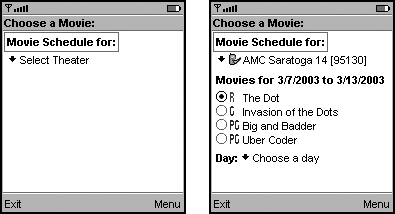Creating and Updating Forms
Keeping forms as short and as simple as possible makes them more usable. For example, users will need to do less traversal and scrolling to complete the form. Short, simple forms also use less memory and can improve performance. Laying out a form can be time consuming. If a device takes a long time to lay out and display a complex form, users will perceive it as a performance problem. After creating a form, an app developer can change, add, or delete its items as needed. This process should not distract the user.
app Developers
Strongly Recommend:
Create forms that contain a small number of closely related items. The form should enable the user to perform one large task or two to three small tasks. The best guide for whether a particular form contains too many items is feedback from usability testing. The screens in Screenshot each show a form that is designed for one task.
Recommend:
Do not change a form's contents while the form is visible, unless it is in response to a user action, such as selecting an item. Making arbitrary changes while the user is interacting with the form can be disorienting, but users understand context-sensitive screens that change in response to their actions. Such forms have more predictable behavior and are faster for users to interact with.
Because an app is notified each time a user changes an item, an app developer could create content-sensitive forms that change their contents as a result of user actions. For example, the form shown in Screenshot contains a custom item (it looks like a choice group with a single element). The item initially displays Select Theater. If the user selects a theater, the form changes to reveal additional items. If the user does not select a theater, the form's content is not changed.
Screenshot Context-Sensitive Form
